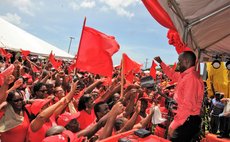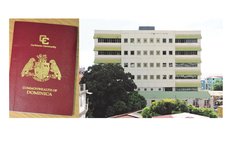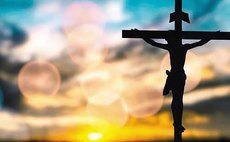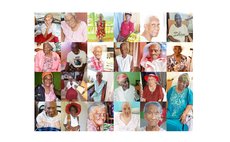Are we on the verge of repeating history?
"We learn from experience that men never learn anything from experience." ― George Bernard Shaw
We are of the opinion that the riots of May 29, 1979 is definitely one of the most significant dates in the short history of Dominica. Yet many, including this newspaper, forgot that date when it came around in 2014. In our view May 29, 1979 is as momentous as Independence, Emancipation, the passage of Hurricane David and the discovery of the island by Christopher Columbus.
May 29, 1979 can be described as Dominica's People's Revolution comparably to the Arab Spring that erupted all over the Arab world beginning in December 2010. If you think back you will remember how these events captivated a huge world-wide television audience as a revolutionary wave of nonviolent and violent demonstrations and protests, riots, and civil wars in the Arab world forced many autocratic leaders out of office.
The Arab Spring disturbances were similar, though on an obviously smaller scale, to the events in Dominica leading to and after the riots of May 29, 1979. These protesters shared techniques of mostly civil resistance in sustained campaigns involving strikes, demonstrations, marches, and rallies. Whereas the Arab Spring made effective use of social media to organize, communicate, and raise awareness in the face of state attempts at repression, the organisers of the May 29, 1979 revolt used what may be considered today to be rudimentary media such as newsletters, leaflets and street-lamp meetings to raise awareness of the excesses of the Patrick John administration. Anthony Astaphan, the unapologetic mouthpiece of the current ruling Dominica Labour Party regime called the revolution the "stone throwing brigade". But May 29 was much more than that.
Frederick Chiluba, the first democratically elected president of Zambia has stated that "The greatest lesson we can learn from the past . . . is that freedom is at the core of every successful nation in the world." And that essentially is the lesson Dominicans may have learnt from May, 29, 1979.
The current economic and social conditions in Dominica and in the period leading up to the civil unrest of May 29, 1979 are so similar that some commentators have predicted that history may be about to repeat itself. We may be wrong but we doubt Dominicans can come together again like they did in 1979 to overthrow an extremely unpopular government even if the economic conditions are similar today.
In their book "In Search of Eden: Essays on Dominican History "authors Irving W. André and Gabriel Christian posit that the sluggish economy in the early seventies and the enactment of draconian laws by the Patrick John regime were the two major causes of the riots.
André argues in an essay in that book entitled "Legislation and Repression in Dominica in the 1970's." that the government pursued a number of ill-fated economic ventures which did nothing to alleviate economic hardship in Dominica. These hardships caused resentment and unrest on the island, and precipitating the enactment of a number of laws which set the stage for the clash between the two parties in 1979. During that period the price of bananas that accounted for 75% of the island's export revenues fell from nine cents to five cents per pound. The prices for bay oil also crashed in 1974.
According to André, the island's precarious economic system was further exacerbated by the paucity of aid from traditional donor countries. The problems of unemployment, declining consumer purchasing power and the paucity of new capital formation combined to create an extremely bleak economic future.
Since the government of Patrick John was strapped for cash it turned to apartheid South Africa, the establishment of a pseudo- free port zone in Portsmouth conceived by Texas businessman Don Pierson, and undertook other questionable capital ventures. Ralph Gonzales, the St. Vincent prime minister aptly described the riots in Dominica as "material contradictions of capitalist underdevelopment followed by dictatorial tendencies within a democratic cloak."
As the population endured that dreadful economy, the Government further risked confrontation with the militant trade unions by enacting the Industrial Relations (Amendment) Act and the Prohibited and Unlawful Societies and Association Act (The Dread Act).
In "The Dominica Story: A History of the Island", Dr. Lennox Honychurch advances the view that the Dominica Civil Service Association and other opposition forces in Dominica angered by the Government's legislative agenda forced a confrontation with the John administration.
In a vivid description of the events on May 29, 1979, Dr. Honychurch wrote that after two weeks of intense campaigning by opposition forces, some 10,000 demonstrators appeared around the House of Assembly at Government Headquarters on the morning of 29 May.
The peaceful demonstration began with police wandering through the crowd. Opposition members were cheered as they entered; government members were jeered and jostled. The Defence Force arrived, tear gas was fired, people scattered. In anger people hiding in the back alleys, their faces covered with damp cloth, threw stones at the army and the cement and glass building towering above the surrounding slums.
The Defence Force opened fire. One youth, Phillip Timothy, was shot dead. Ten others were injured, four critically. These events and others which followed led to a "palace coup"; it ended the reign of Patrick John on 21 June, 1979.
A few years ago Oliver Seraphine, the former Prime Minister of the Interim Government that ruled after John was overthrown, suggested that the events of 29th May, 1979 should be forgotten and since the two antagonists in 1979, the Dominica Labour Party and the Dominica Freedom Party, had formed a Coalition Government three decades after the riots the history of the events should be re-written. The current government for obvious reasons agrees with Seraphine and will not want the public to dwell too much on May 29, 2009. In fact, to drive home the point, the government erased a mural of the shooting of Timothy, on the Treasury building on Hillsborough Street.
We do not agree with that decision because, if we are allowed to repeat a cliché, those who forget the mistakes of the past may, inadvertently, repeat them.




